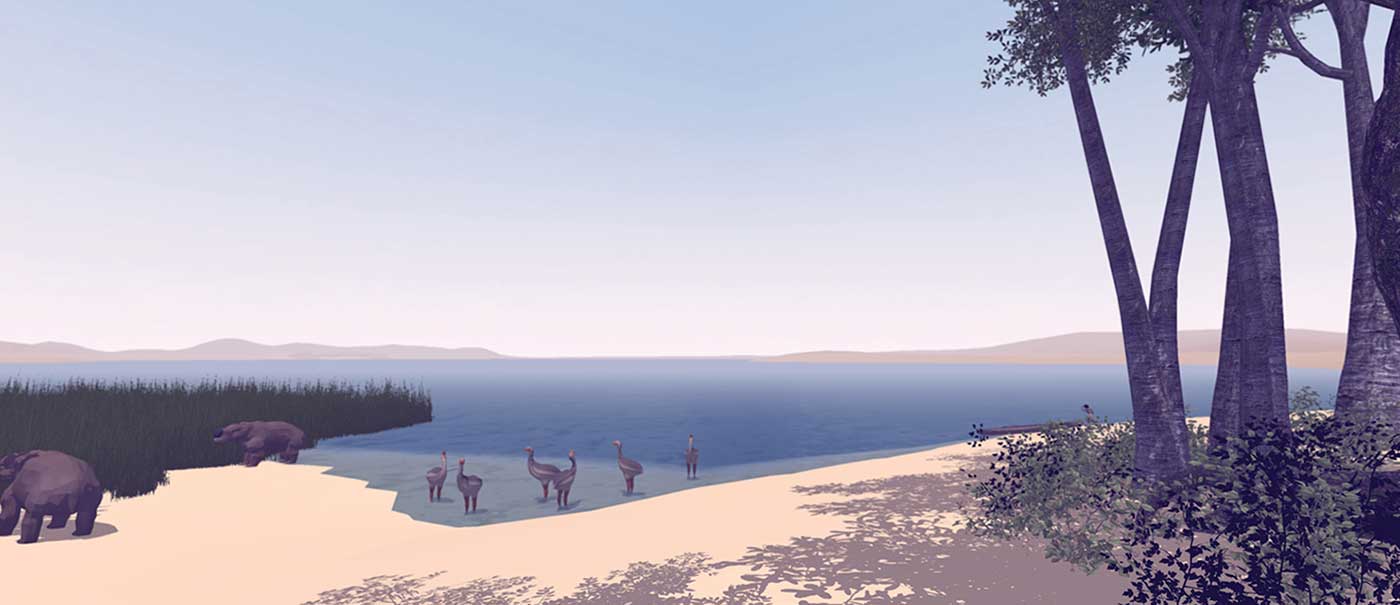Welcome
Our Lake Mungo teacher resources include creative projects, assignment questions and online activities, all linked to the Australian Curriculum.
They were developed for use with our Kids learning space, where videos, photographs and background help provide answers and inspiration for students.

Setting the scene
Kspace took visitors to Lake Mungo, 45,000 years ago. People have inhabited the Australian continent for many tens of thousands of years, before animals including diprotodons and giant goannas were extinct.
Questions children can keep in mind:
- What do you notice about the animals in the scene? Are they familiar?
- What objects and technologies are present in the scene?
- What are people in the scene doing? What did they have to eat?
- Download Lake Mungo visitor access guide4.2 mb pdf [ PDF | 4.2 mb ]
Primary source study
A suitcase used by archaeologist John Mulvaney to transport the remains of Mungo Lady to the Australian National University, Canberra, in 1969, is now part of the National Museum’s collection.
Online quiz
Ten multiple choice questions for students to demonstrate their knowledge of Lake Mungo. The quiz questions and answers are also available in a printable version PDF, 100.33 KB
Exercises
Exercise 1: Online
Twenty questions for students to demonstrate their understanding of animals found at Lake Mungo 45,000 years ago.
Start the Lake Mungo online exercise
Students can work together or by themselves to cut and paste the words from the answer sheets, or they can write their answers to the questions in the spaces provided.
- Download What kind of animal am I?7.0 mb pdf [ PDF | 7.0 mb ]
Creative projects
Suggested projects for children to make and do.
- Create a picture or diorama of a Lake Mungo landscape and its inhabitants 45,000 years ago.
- Devise a timeline, showing major events at Lake Mungo over the past 200,000 years.
- Produce two images of Lake Mungo; one as it is today, and the other as it may have looked 45,000 years ago.
- Create a comic strip or story, based on the events that led to the footsteps at Lake Mungo being created 20,000 years ago.
- Write and perform a play featuring scientists discussing the extinction of Australia’s megafauna.
- Produce a PowerPoint presentation on the significance of Lake Mungo to Indigenous people and scientists.
- Draw a picture of a people interacting with extinct megafauna at Lake Mungo.
Written assignments
Suggested assignments questions encouraging children to think and write.
- What does the evidence at Lake Mungo reveal about the peopling of Australia?
- What are some of the theories proposed to explain the disappearance of Australia’s megafauna?
- What are some of the most important archaeological discoveries at Lake Mungo? How do they compare to discoveries elsewhere in Australia and the world?
- For what reasons is the Willandra Lakes region listed on the World Heritage register?
- How has the landscape of the Lake Mungo region changed over the past 200,000 years, and what natural processes have influenced this change?
- Studies involving remains found at Lake Mungo have been central to a number of scientific controversies. Use the sources below to identify and discuss some of these debates.
a. ‘Mungo Man’ on the ABC Science website
b. ’Ancient bones found at Lake Mungo on the ABC website
c. ‘Mungo Man’s age rattles a few bones’ on The Age website
d. ‘How old are Mungo Lady and Mungo Man?’ on the Mungo National Park website
e. ‘Further controversy on human origins’ on the ABC Science website
f. ‘Out of Darkness’ film clip on the Australian Screen website - Animals in Australia are different to those found in other parts of the world. Discuss the impact of these differences for the first people arriving in Australia.
- The remains of Mungo Lady were returned to the traditional owners of Lake Mungo in 1992. Why is it important to Indigenous communities for human remains to be returned to their country?
- Discuss the painting Lake Mungo People. How sure can we be that elements within the image are accurate, and how much is speculation?
Note: inspiration and answers for these online activities, creative projects and written assignments can be found in the Kids learning space
You may also like